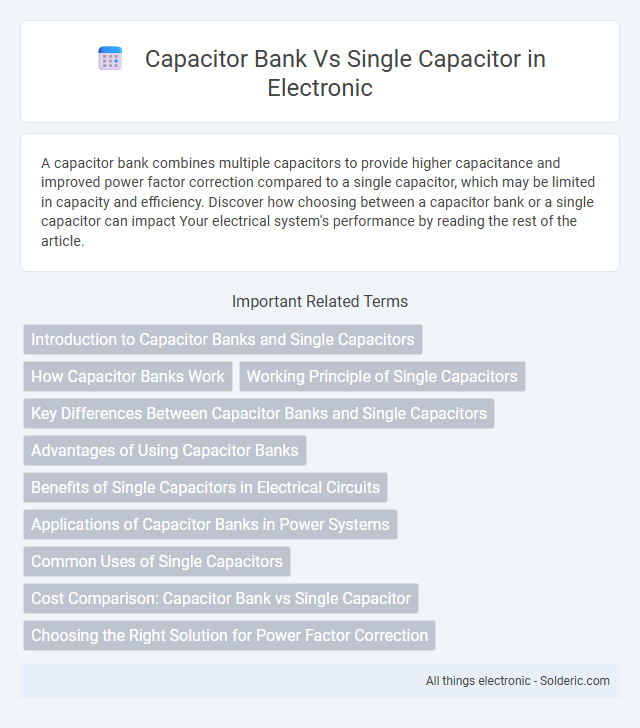A capacitor bank combines multiple capacitors to provide higher capacitance and improved power factor correction compared to a single capacitor, which may be limited in capacity and efficiency. Discover how choosing between a capacitor bank or a single capacitor can impact Your electrical system's performance by reading the rest of the article.
Comparison Table
| Feature | Capacitor Bank | Single Capacitor |
|---|---|---|
| Definition | Group of capacitors connected in series or parallel to increase capacitance or voltage rating | Single capacitor unit with specific capacitance and voltage rating |
| Capacitance Range | Higher total capacitance by combining multiple capacitors | Fixed capacitance value |
| Voltage Rating | Can handle higher voltages by series connection | Limited to single capacitor's voltage rating |
| Application | Power factor correction, harmonic filtering, reactive power compensation in industrial setups | Small-scale circuits, filtering, timing applications |
| Flexibility | Modular and scalable capacity | Fixed capacity, less flexible |
| Cost | Higher initial investment but cost-effective for large capacitance | Lower cost for small capacitance requirements |
| Maintenance | More complex due to multiple components | Simple maintenance |
Introduction to Capacitor Banks and Single Capacitors
Capacitor banks consist of multiple capacitors connected in series or parallel to provide higher capacitance and improved voltage handling, making them ideal for large-scale power factor correction and energy storage applications. Single capacitors, by contrast, serve specific, lower-capacitance needs in smaller circuits or devices where precise tuning and compact size are crucial. Your choice between a capacitor bank and a single capacitor depends on the scale and complexity of the electrical system you are optimizing.
How Capacitor Banks Work
Capacitor banks consist of multiple capacitors connected in series or parallel to provide higher capacitance and voltage ratings compared to a single capacitor. They store and release electrical energy by charging and discharging, improving power factor and voltage stability in electrical systems. Capacitor banks enhance reactive power compensation, reduce energy losses, and optimize the efficiency of electrical networks more effectively than individual capacitors.
Working Principle of Single Capacitors
A single capacitor stores electrical energy in an electric field while charging and releases it when discharging, smoothing voltage fluctuations and improving power factor in your circuit. Its working principle relies on the ability to accumulate and maintain a charge across two conductive plates separated by an insulating dielectric material. This simple energy storage mechanism differs from a capacitor bank, which combines multiple capacitors to handle larger power demands and enhance system stability.
Key Differences Between Capacitor Banks and Single Capacitors
Capacitor banks consist of multiple capacitors connected in series or parallel to achieve higher capacitance and voltage ratings, whereas single capacitors have a fixed capacitance and voltage rating. Capacitor banks provide improved power factor correction, voltage stabilization, and load balancing in electrical systems, while single capacitors typically support simpler applications with limited capacity. The modularity and scalability of capacitor banks enable enhanced reliability and maintenance flexibility compared to the singular design of individual capacitors.
Advantages of Using Capacitor Banks
Capacitor banks offer better power factor correction by combining multiple capacitors to handle larger loads more efficiently than a single capacitor. They provide scalability, allowing for incremental adjustments to reactive power compensation, which enhances system stability and reduces energy losses. Maintenance is simplified due to modular design, improving reliability and flexibility in industrial and commercial electrical systems.
Benefits of Single Capacitors in Electrical Circuits
Single capacitors in electrical circuits provide precise tuning for filtering and resonance applications, ensuring stable voltage regulation and improved power factor. Their simplicity reduces installation and maintenance costs while minimizing space requirements on circuit boards. Single capacitors also offer targeted energy storage and discharge capabilities, enhancing overall circuit efficiency and performance.
Applications of Capacitor Banks in Power Systems
Capacitor banks, compared to single capacitors, provide improved reactive power compensation and voltage stabilization in power systems, making them essential for maintaining power quality and efficiency. They are widely used in industrial plants, transmission lines, and distribution networks to reduce power losses and avoid voltage drops under varying load conditions. Your power system benefits from capacitor banks through enhanced load balancing, reduced energy costs, and increased equipment lifespan.
Common Uses of Single Capacitors
Single capacitors are commonly used in electronic circuits for filtering, decoupling, and timing applications where precise control of voltage and current is necessary. They are essential components in power supply stabilization, signal processing, and noise reduction for devices such as radios, amplifiers, and microcontrollers. Your circuits benefit from single capacitors' simplicity and targeted functionality in achieving stable operation and efficient energy management.
Cost Comparison: Capacitor Bank vs Single Capacitor
Capacitor banks typically offer a more cost-effective solution for power factor correction in large-scale electrical systems compared to single capacitors, as they provide multiple capacitors combined into one unit, enabling higher capacitance at a lower cost per kilovolt-ampere reactive (kVAR). Single capacitors, while simpler and less expensive upfront, often result in higher operational costs due to limited capacity and reduced efficiency in handling fluctuating loads. Investing in capacitor banks reduces long-term expenses through improved energy savings, reduced utility penalties, and lower maintenance costs.
Choosing the Right Solution for Power Factor Correction
Capacitor banks offer scalable and balanced power factor correction by combining multiple capacitors to handle varying load demands efficiently. Single capacitors provide a simpler, cost-effective solution but may lack the flexibility and precision needed for fluctuating power requirements. Evaluating your facility's load profile and correction needs ensures optimal power factor improvement and energy savings.
Capacitor bank vs single capacitor Infographic

 solderic.com
solderic.com